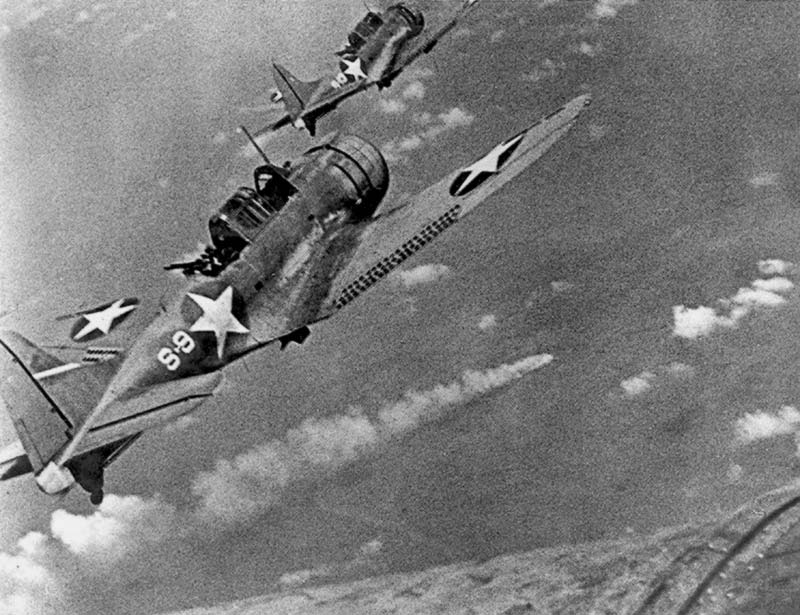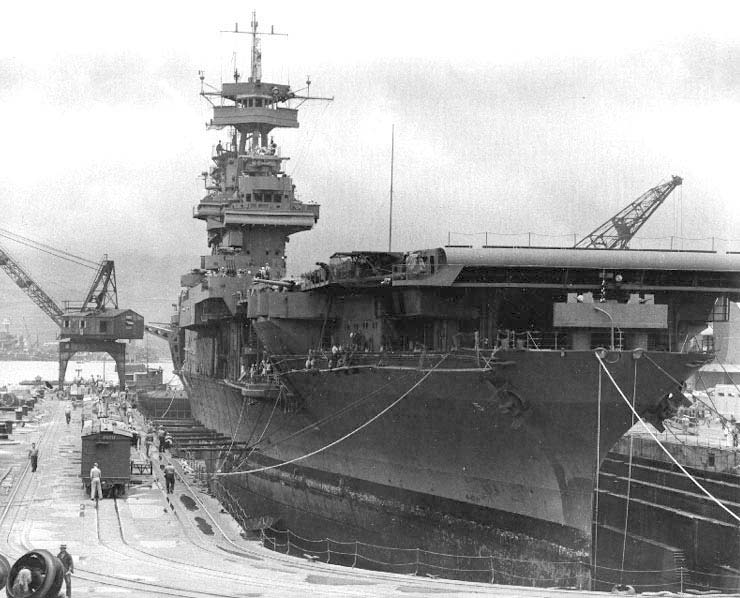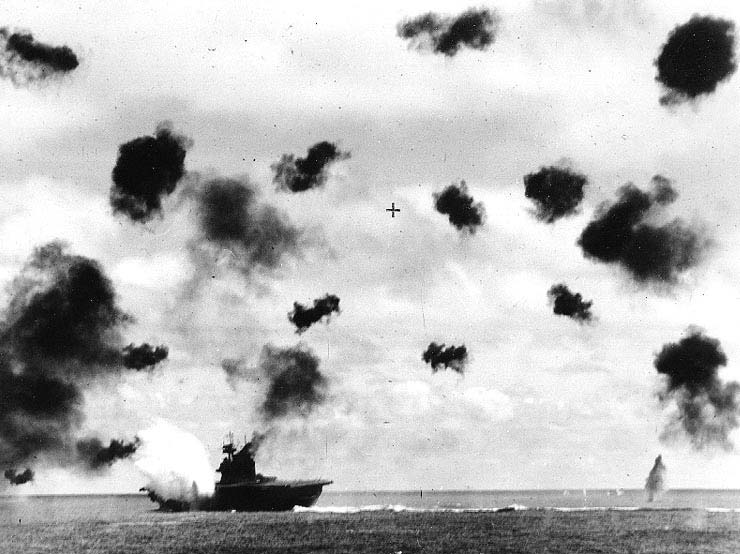| Battle of Midway | |||||||
|---|---|---|---|---|---|---|---|
 |
|||||||
|
|||||||
| Contenders | |||||||
| Military Leaders | |||||||
| Unit Strength | |||||||
| 3 carriers ~25 support ships 233 carrier-based aircraft 127 land-based aircraft |
4 carriers 2 battleships ~15 support ships 248 carrier-based aircraft 16 floatplanes |
||||||
| Casualties and Deaths | |||||||
| 1 carrier sunk 1 destroyer sunk ~150 aircraft destroyed 307 killed |
4 carriers sunk 1 cruiser sunk 248 carrier aircraft destroyed 3,057 killed |
||||||
| Part of World War II | |||||||
The Battle of Midway was a naval battle between the U.S. and Japan that took place between 4th and 7th of June, 1942. This was about 6 months after Japan bombed Pearl Harbor. Japan had won many battles after Pearl Harbor and thus they were very strong in the Pacific. The battle derives its name from the location on which it took place which is near the Midway Island in the Pacific Ocean.
The U.S. had a huge part of its fleet at Midway which was considered to be strategically important because of its proximity to the Hawaiian Islands. To weaken the naval power of America, Japan decided to attack Midway hence the battle. This is one of the battles that are considered as having been the most important battles of the Pacific campaign during World War II.
Before the battle took place, Japan enjoyed naval supremacy over the U.S. and they would decide where and when they would attack. This battle destroyed Japan’s naval strength effectively. During the battle the American Navy inflicted damage to the Japanese fleet which they did not recover from. Both parties sustained losses in the battle, but Japan was not able to reorganize its naval forces as it was industrially outstripped by America in terms of providing quick replacements to their lost fleets. Consequently, the American Navy was able to grab the initiative on the Pacific Ocean and go on the offensive.
Prelude to the Battle
In May 1942, American cryptologists informed the military about Japan’s intention to attack one of the Pacific islands. At first the code breakers were uncertain of the location. They devised a plan to discover a location coded as AF by Japan. Later they managed to intercept a Japanese transmission which confirmed the destination as Midway.
 The U.S. commander Admiral Chester Nimitz heard the news and sent all the ships to the defense of Midway. The battle ships were sent immediately after the target was identified. Unfortunately, the Japanese forces did not have their submarines in place to detect the ships presence. The other U.S. commanders in charge of the operation were Rear admiral Frank J. Fletcher and Raymond Spruance. The imperials of the Japanese side were Admiral Isoroku Yamamoto and Vice Admiral Chuichi Nagumo. The participating forces in the Japanese side were organized into five forces:
The U.S. commander Admiral Chester Nimitz heard the news and sent all the ships to the defense of Midway. The battle ships were sent immediately after the target was identified. Unfortunately, the Japanese forces did not have their submarines in place to detect the ships presence. The other U.S. commanders in charge of the operation were Rear admiral Frank J. Fletcher and Raymond Spruance. The imperials of the Japanese side were Admiral Isoroku Yamamoto and Vice Admiral Chuichi Nagumo. The participating forces in the Japanese side were organized into five forces:
» Forward patrol (16 submarines) to detect the American presence as soon as they arrive and possibly attack.
» 4 aircraft carriers to attack American carriers upon arrival.
» Invasion forces to bring the Japanese marines to Midway.
» 7 battleships and a light aircraft carrier.
» A Diversion force whose task was to attack and invade the Aleutian Islands near Alaska.
The American forces on the other hand just had three aircraft carriers which were escorted by heavy cruisers and destroyers. They also had 115 fighters and bombers based in the Midway island.
Why the Battle Occurred
 Japan’s Navy wanted to remove the U.S. out of the picture in the Pacific operations at Midway. Just like in their prior attack on Pearl Harbor that pushed the U.S. into war, the Battle of Midway was not part of a campaign for the take-over of America instead, it was geared at its removal as a strategic Pacific power in order to give Japan complete freedom to launch its Greater East Asia Co-Prosperity Sphere.
Japan’s Navy wanted to remove the U.S. out of the picture in the Pacific operations at Midway. Just like in their prior attack on Pearl Harbor that pushed the U.S. into war, the Battle of Midway was not part of a campaign for the take-over of America instead, it was geared at its removal as a strategic Pacific power in order to give Japan complete freedom to launch its Greater East Asia Co-Prosperity Sphere.
Japan also hoped that if they defeated America again, they would push the U.S. into negotiations to end the Pacific war with favorable conditions for them. In addition to that, Japan had intentions of occupying Midway as part of their general objective to expand the defensive boundaries after the Doolittle Air Raid on Japan which was a preparatory attack before taking the islands of Fiji and Samoa.
Japan had planned to capture Midway to use it as its advance base and also to trap and damage the American fleet. However, without the knowledge of Japanese intelligence, the American cryptologists gained communication intelligence that enabled them to assess the location and date of the Midway operation prior to the attack. This enabled the U.S. forces to organize their own ambush at Midway, rendering initial Japanese planning, theories of combat dispositions, and American reactions void. The Japanese forces were surprised by the sinking of their 4 carriers that had been used in attack at the Pearl Harbor 6 months prior. The U.S. lost one carrier and they took the offensive in the Pacific with their allies.
The Aftermath
On June 9th, two survivors were rescued from a sunken heavy Japanese cruiser Mikuma. Slightly over a week after, thirty five Japanese survivors who were members of the engineering department who had been left for dead were rescued by the seaplane tender USS Ballard AVD-10.
On June 21st, another two survivors were rescued by a PBY from VP-24 at about three sixty miles north of Midway. Those were the last survivors to be rescued from the battle. After gaining clear victory, the U.S. Navy retired. The loss of Japan’s fleet carriers and most of its trained crews stopped the expansion of the Japanese Empire in the Pacific region. The balance of naval supremacy in the Pacific Ocean moved from the Japanese to stalemate between America and Japan. Soon after the conclusion of the battle, the U.S. and her allies took the offensive in the Pacific.
The consequences of this battle for the Japanese were quite significant. In the blink of an eye, Japan lost 4 of its most important carriers which were of great importance in the Pacific campaign. They also lost a large number of their experienced crewmen in the battle.
The Japanese navy learned some valuable lessons from this battle. They adopted new procedures where more aircraft was refueled and re-armed on the flight deck rather than in the hangars. They built new carriers that incorporated just 2 flight deck elevators and new fire-fighting equipment. They also trained more carrier crew in fire-fighting techniques and damage control. This battle also taught the Americans and Japanese the importance of using the aircraft carriers over the battleship as aircraft carriers could strike over long distances.
Some experts view this battle as the turning point in the Pacific war. Later, the U.S. Marines went directly to Tokyo. Others may look at it as a cusp in the in the war after which the initiative hung in the balance, to go toward the Allied forces in the Guadalcanal campaign. Whichever way you look at it, this battle ranks among the truly decisive battles.